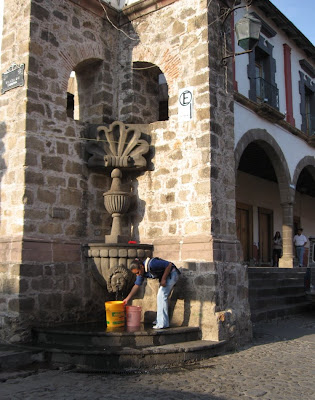 Monarch butterflies from Canada, the Great Lakes and eastern U.S. migrate some 3,000 miles south each fall to mountaintops in Michoacán, central Mexico, to hibernate. It´s considered one of the world´s great animal migrations.
Monarch butterflies from Canada, the Great Lakes and eastern U.S. migrate some 3,000 miles south each fall to mountaintops in Michoacán, central Mexico, to hibernate. It´s considered one of the world´s great animal migrations.We hiked from the village of El Rosario up to the Monarch Butterfly Reserve, a cool fir and pine forest at about 10,000 feet. Until 1975, scientists who study the butterfly were unaware of this hibernation site. Now it´s supposedly protected, but it´s surrounded by villages of poor folks who are unemployed and need money. Logging is a source of income.
The Wall Street Journal just did an article on the efforts to protect the Reserve. The World Wildlife Fund chronicles activities to encourage preservation and recovery of forest illegally harvested in the reserve.
 It´s estimated that some 100 million to 200 million monarchs winter here. This photo by Cindy shows how they huddle together on branches for warmth. The day we were there was sunny, so a few were moving around to get water. They live off fat reserves stored up during their migration to tide them over to February, when they become active again, and migrate north to Texas and Oklahoma where they mate and lay eggs.
It´s estimated that some 100 million to 200 million monarchs winter here. This photo by Cindy shows how they huddle together on branches for warmth. The day we were there was sunny, so a few were moving around to get water. They live off fat reserves stored up during their migration to tide them over to February, when they become active again, and migrate north to Texas and Oklahoma where they mate and lay eggs.In a kind of relay, the monarchs produce several generations as they migrate north, reproduce and die off. It is only the generation that hatches in late summer that migrates south and lives for eight or nine months. MonarchWatch.org has more information on the migration here.

This is part of the El Rosario community, which charges admission to the site and maintains the surrounding areas. They operate dozens of little souvenir and food stands along the route up to the reserve.
We stayed in Zitácuaro the night before going up to the reserve. It´s a very busy provincial town, not very attractive, but the hotel, the Maria Fernanda, was excellent and cheap.
And of course there is an article on Wikipedia.
Tlalpujahua, with mines of silver and gold
 After visiting the reserve we stayed in Tlalpujahua, which bills itself as the Magic Pueblo, and it truly is a lovely small place with lots of interesting buildings.
After visiting the reserve we stayed in Tlalpujahua, which bills itself as the Magic Pueblo, and it truly is a lovely small place with lots of interesting buildings. The town´s wealth came from silver and gold mines, which explains how a little place like this could have such a magnificent church.
 The town´s cobbled streets and well preserved colonial architecture captured Cindy´s eye.
The town´s cobbled streets and well preserved colonial architecture captured Cindy´s eye.
No comments:
Post a Comment